
Duke of Norfolk is a title in the peerage of England, and is the premier non-royal peerage. The seat of the Duke of Norfolk is Arundel Castle in Sussex, although the title refers to the county of Norfolk. The current duke is Edward Fitzalan-Howard, 18th Duke of Norfolk. The dukes have historically been Catholic, a state of affairs known as recusancy in England.

The College of Arms, or Heralds' College, is a royal corporation consisting of professional officers of arms, with jurisdiction over England, Wales, Northern Ireland and some Commonwealth realms. The heralds are appointed by the British Sovereign and are delegated authority to act on behalf of the Crown in all matters of heraldry, the granting of new coats of arms, genealogical research and the recording of pedigrees. The College is also the official body responsible for matters relating to the flying of flags on land, and it maintains the official registers of flags and other national symbols. Though a part of the Royal Household of the United Kingdom, the College is self-financed, unsupported by any public funds.
Baron Beaumont is an ancient title in the Peerage of England, created in 1309 for a younger branch of the French counts of de Brienne family. The sixth Baron Beaumont was created Viscount Beaumont in 1432; after the death of his son the 2nd Viscount both titles fell into abeyance.
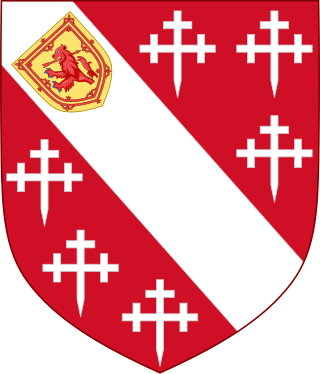
The Howard family is an English noble family founded by John Howard, who was created Duke of Norfolk by King Richard III of England in 1483. However, John was also the eldest grandson of the 1st Duke of the first creation. The Howards have been part of the peerage since the 15th century and remain both the Premier Dukes and Earls of the Realm in the Peerage of England, acting as Earl Marshal of England. After the English Reformation, many Howards remained steadfast in their Catholic faith as the most high-profile recusant family; two members, Philip Howard, 13th Earl of Arundel, and William Howard, 1st Viscount Stafford, are regarded as martyrs: a saint and a blessed respectively.

Edward William Fitzalan-Howard, 18th Duke of Norfolk,, styled Earl of Arundel between 1975 and 2002, is a British peer who holds the hereditary office of Earl Marshal and, as Duke of Norfolk, is the most senior peer in the peerage of England. He is also the titular head of the House of Howard.

Sir Albert William Woods was an English officer of arms, who served as Garter Principal King of Arms from 1869 to 1904. The Woods family has a strong tradition of service at the College of Arms. Albert Woods was the son of Sir William Woods, Garter King of Arms from 1838 until his death in 1842. Likewise, the grandson of Albert Woods was Sir Gerald Woods Wollaston, who also rose to the rank of Garter King of Arms and served there from 1930 until 1944.

Norroy and Ulster King of Arms is the provincial King of Arms at the College of Arms with jurisdiction over England north of the Trent and Northern Ireland. The two offices of Norroy and Ulster were formerly separate. Norroy King of Arms is the older office, there being a reference as early as 1276 to a "King of Heralds beyond the Trent in the North". The name Norroy is derived from the Old French nort roy meaning 'north king'. The office of Ulster Principal King of Arms for All-Ireland was established in 1552 by King Edward VI to replace the older post of Ireland King of Arms, which had lapsed in 1487.

Beaumont Herald of Arms Extraordinary was an officer of arms extraordinary in England. Beaumont was a royal herald, but was not a member of the College of Arms. The office was created in 1982 and named after the barony of Beaumont, one of the subsidiary titles of the Earl Marshal, the Duke of Norfolk. The badge of office combines the cross potent of the Kings of Jerusalem from whom the Beaumonts are descended, with the lion and fleur-de-lis charges from the family coat of arms. It is blazoned In front of a Cross Potent a Lion rampant within eight Fleurs-de-lis in orle Or.
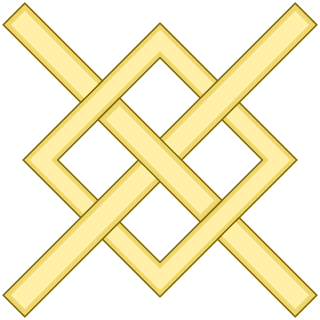
Maltravers Herald of Arms Extraordinary is a current officer of arms extraordinary in England. As such, Maltravers is a royal herald, but is not a member of the College of Arms in London. The present office was created in 1887 by the Earl Marshal, who was also the Duke of Norfolk and Baron Maltravers. The office is known to have been held by a pursuivant to Lord Maltravers when he was deputy of Calais from 1540 to 1544. The badge is blazoned as A Fret Or. It was officially assigned in 1973, though it had been assumed by two Maltravers Heralds in the 1930s. It derives from the coat of arms of Maltravers Sable a Fret Or and a Label of the points Ermine, and was the badge of John, Earl of Arundel through which family the barony passed to the Howard dukes of Norfolk.

Norfolk Herald of Arms Extraordinary is an officer of arms in England. As an officer extraordinary, Norfolk is a royal herald, though not a member of the corporation of the College of Arms in London. Beginning in 1539 this officer was a herald to the dukes of Norfolk, though the first holder, John James, was paid a salary by King Henry VIII. Subsequent Norfolk heralds have been officers extraordinary, though the office has not always been filled but rather revived when required. The badge of office, assigned in 1958, is blazoned as Two Ostrich Feathers saltirewise each charged with a Gold Chain laid along the quill. It derives from the ostrich feather badge granted by King Richard II around 1387 as a mark of special favor to Thomas Mowbray, Duke of Norfolk, Marshal of England. Mowbray was also the first to be styled Earl Marshal.

Fitzalan Pursuivant of Arms Extraordinary is a current officer of arms in England. As a pursuivant extraordinary, Fitzalan is a royal officer of arms, but is not a member of the corporation of the College of Arms in London. As with many other extraordinary offices of arms, Fitzalan Pursuivant obtains its title from one of the baronies held by the Duke of Norfolk, Earl Marshal of England; the appointment was first made for the coronation of Queen Victoria in 1837. The badge of office was assigned in 1958 and is derived from a Fitzalan badge of the fifteenth century. It can be blazoned An Oak Sprig Vert Acorns Or, but is also recorded as A Sprig of Oak proper.
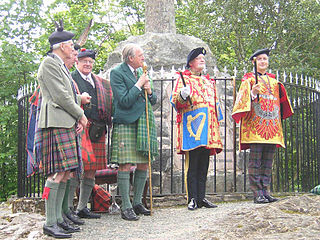
A private officer of arms is one of the heralds and pursuivants appointed by great noble houses to handle all heraldic and genealogical questions.
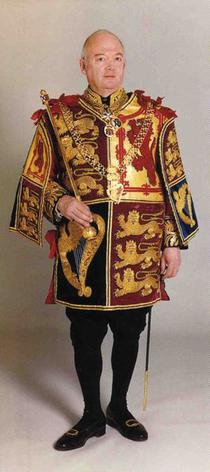
John Philip Brooke Brooke-Little was an English writer on heraldic subjects, and a long-serving herald at the College of Arms in London. In 1947, while still a student, Brooke-Little founded the Society of Heraldic Antiquaries, now known as the Heraldry Society and recognised as one of the leading learned societies in its field. He served as the society's chairman for 50 years and then as its president from 1997 until his death in 2006.
Sir Walter John George Verco was a long-serving officer of arms who served in many capacities at the College of Arms in London.

Surrey Herald of Arms Extraordinary was an English officer of arms. Though an officer of the crown, Surrey Herald Extraordinary was not a member of the corporation of the College of Arms in London. This office was created in 1856 and first held by Edward Stephen Dendy. The badge of office was assigned in 1981. The badge is blazoned Within a representation of a Herald's Collar of SS Argent a Tabard chequy Or and Azure. These were the arms of John de Warenne, Earl of Surrey in the late thirteenth century, from whom the earldom descended through the Fitzalans to the Howard dukes of Norfolk and earls marshal.

Walter Aston Edward Blount Esq. FSA was a long-serving officer of arms at the College of Arms in London. He was born the eldest son of Edward Blount, the third, but second surviving, son of Sir Walter Blount, 6th Baronet of Sodington, Worcestershire.
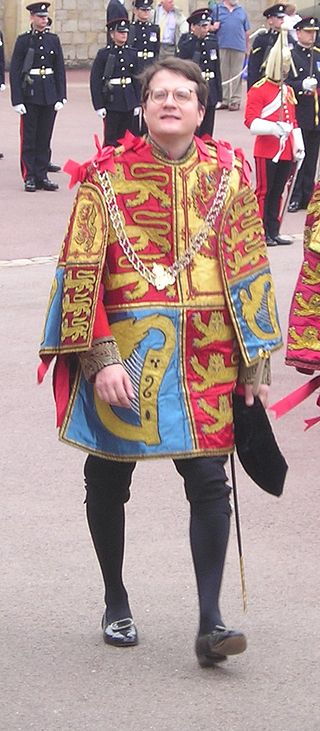
Robert John Baptist Noel is an officer of arms at the College of Arms in London. Formerly the Bluemantle Pursuivant, then the Lancaster Herald, he has been Norroy and Ulster King of Arms since April 2021.
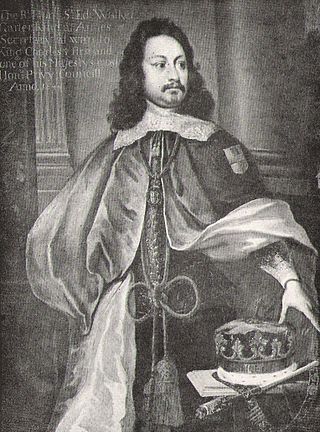
Sir Edward Walker was an officer of arms and antiquarian who served as Garter King of Arms.
Blanche Lyon Pursuivant of Arms in Ordinary was an English office of arms created during the reign of King Edward IV.
Lawrence Dalton was an officer of arms at the College of Arms in London. Dalton was one of thirteen children of Roger Dalton of Bispham, Lancashire, and his fourth wife. Lawrence Dalton also had two half-brothers and one half-sister from his father's first marriage. Little is known about Dalton's early life, and he is not known to have attended a university.

















